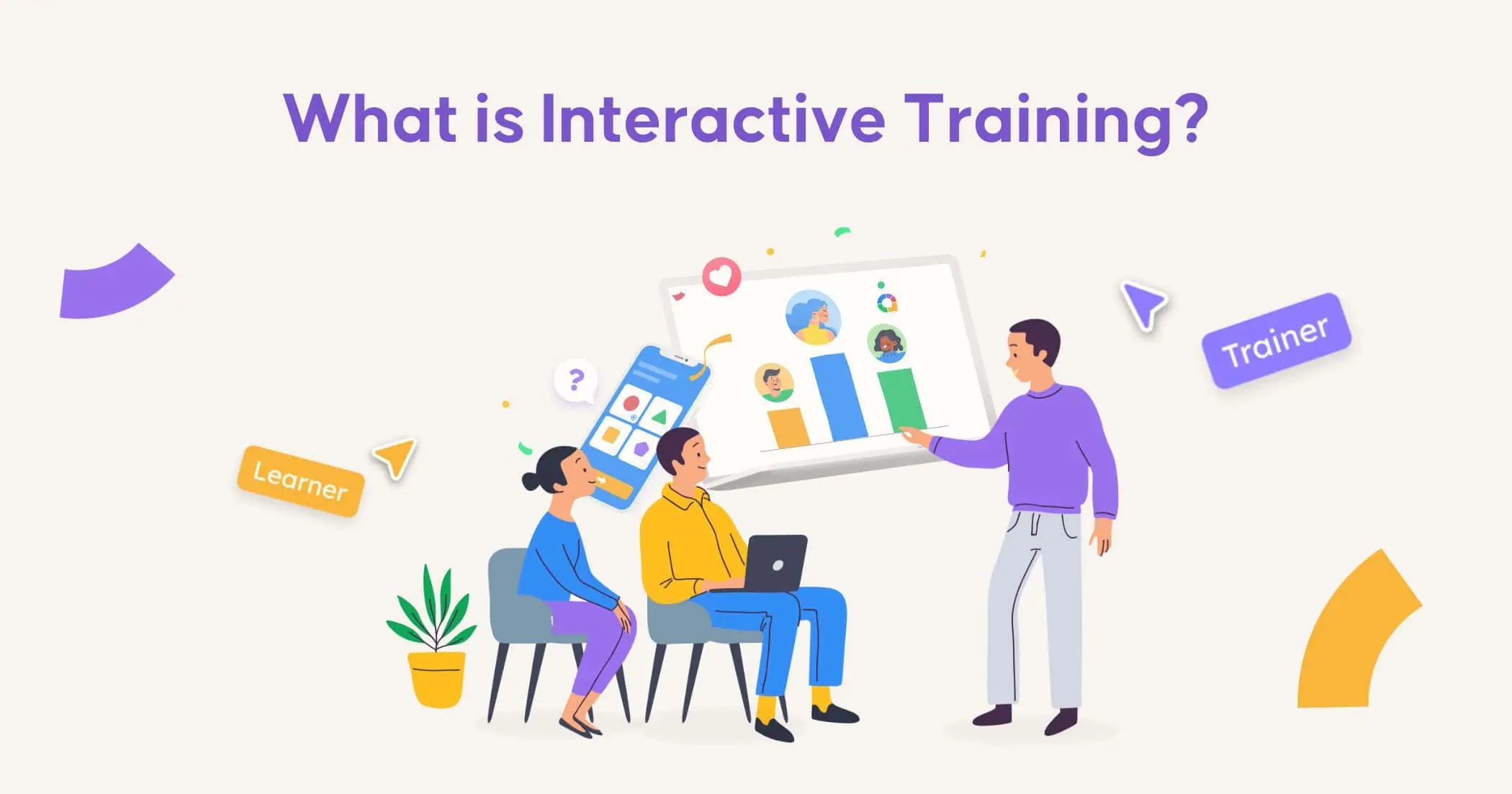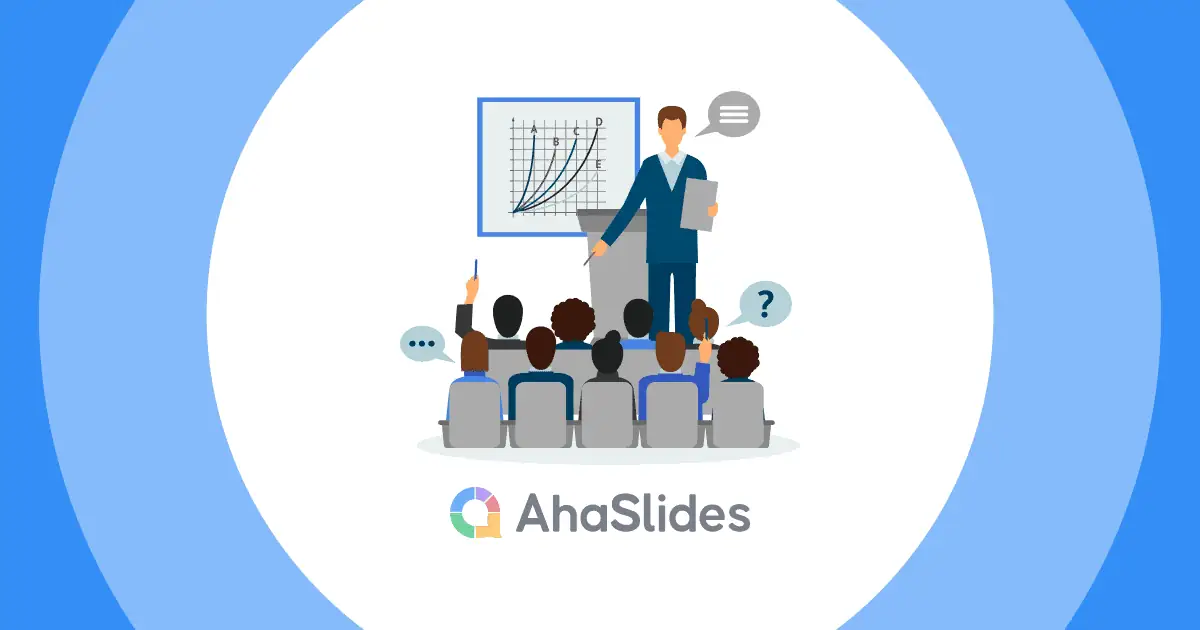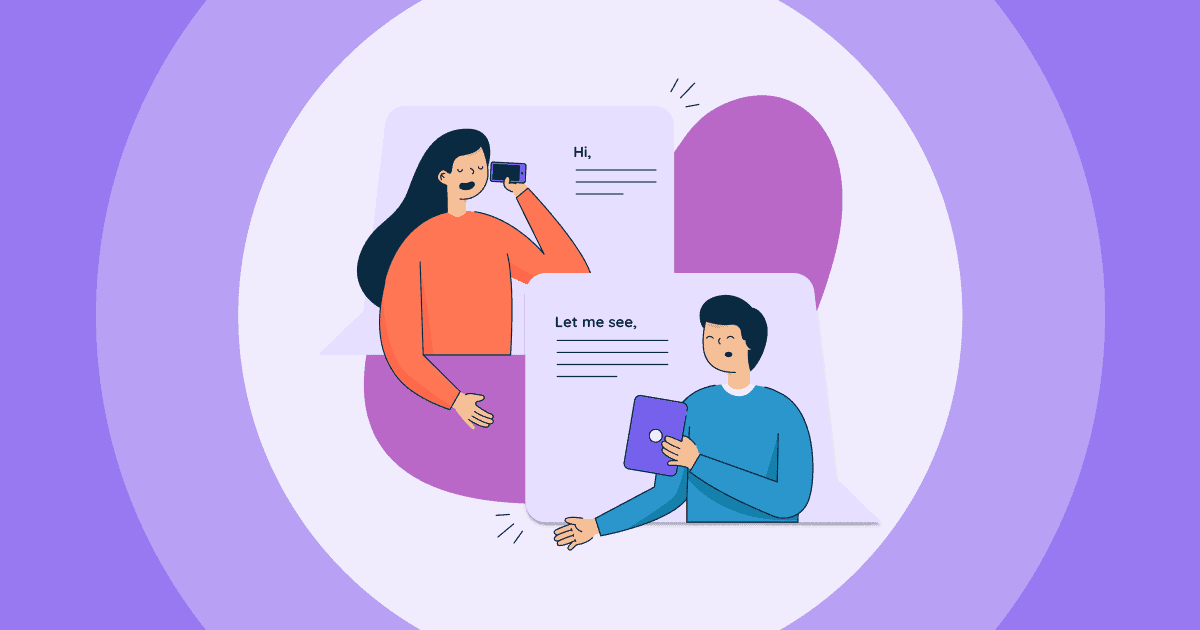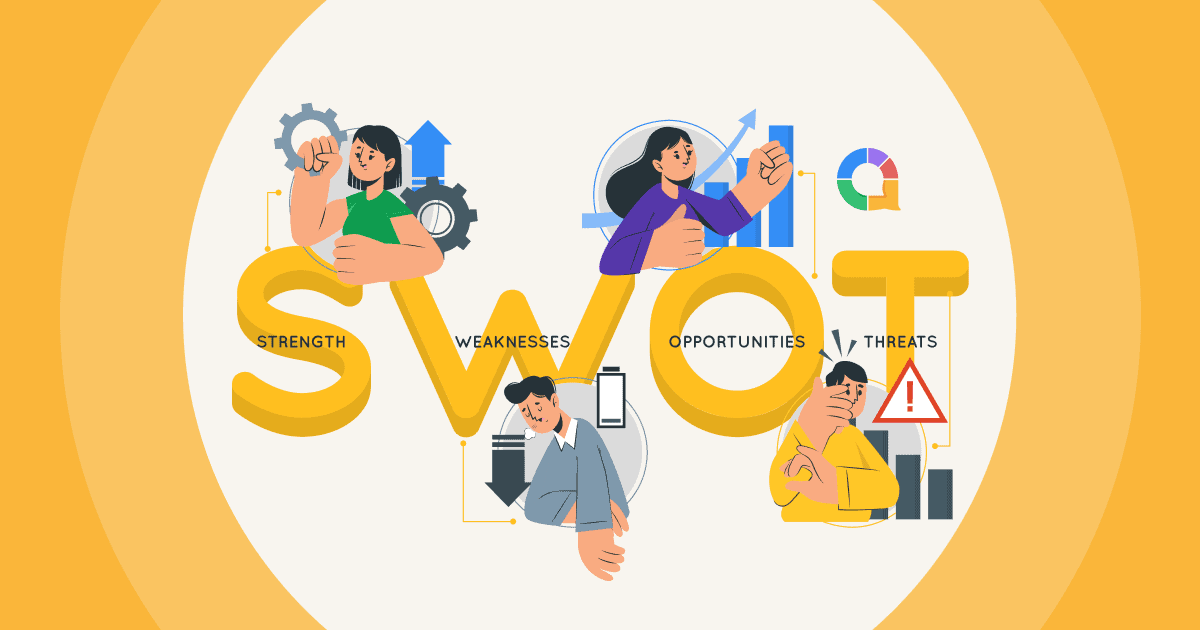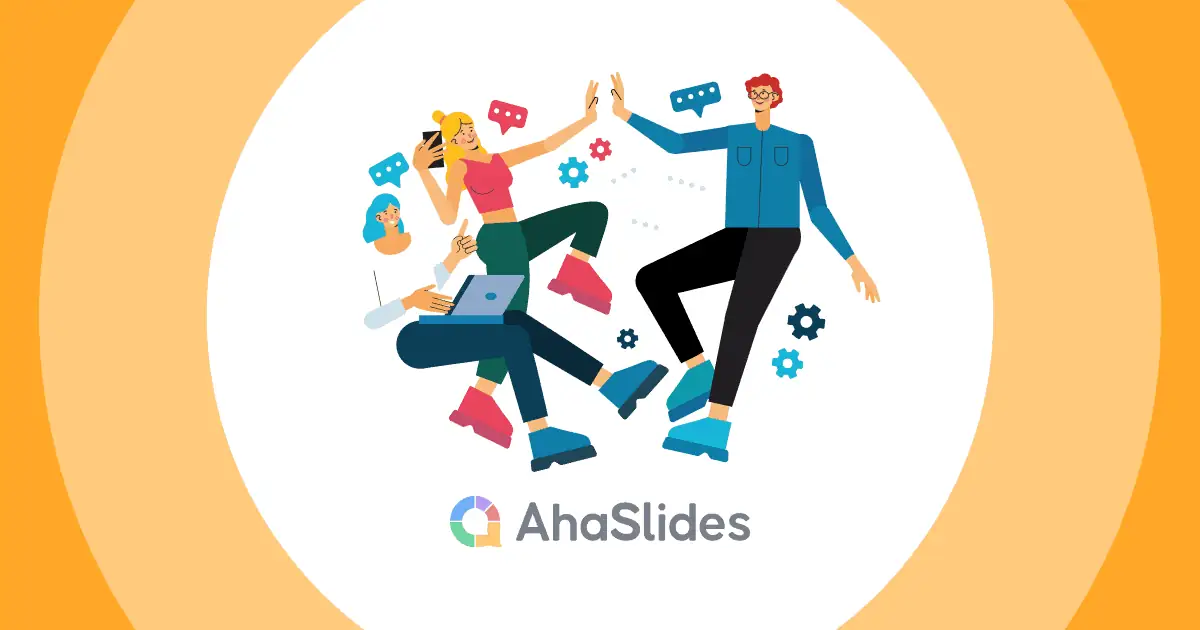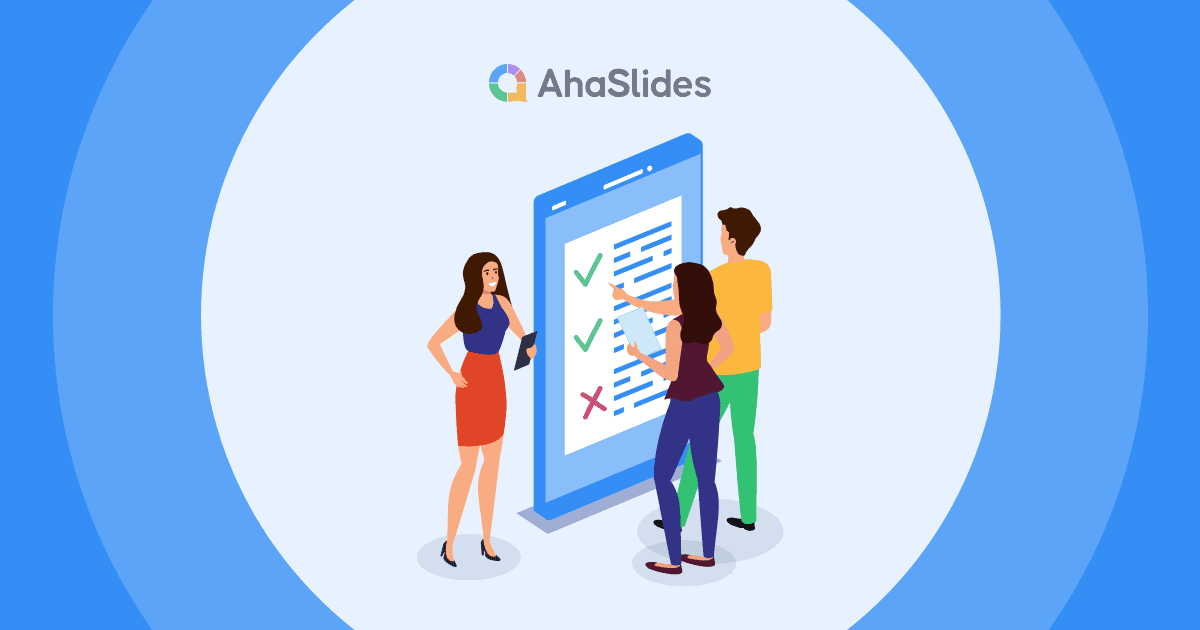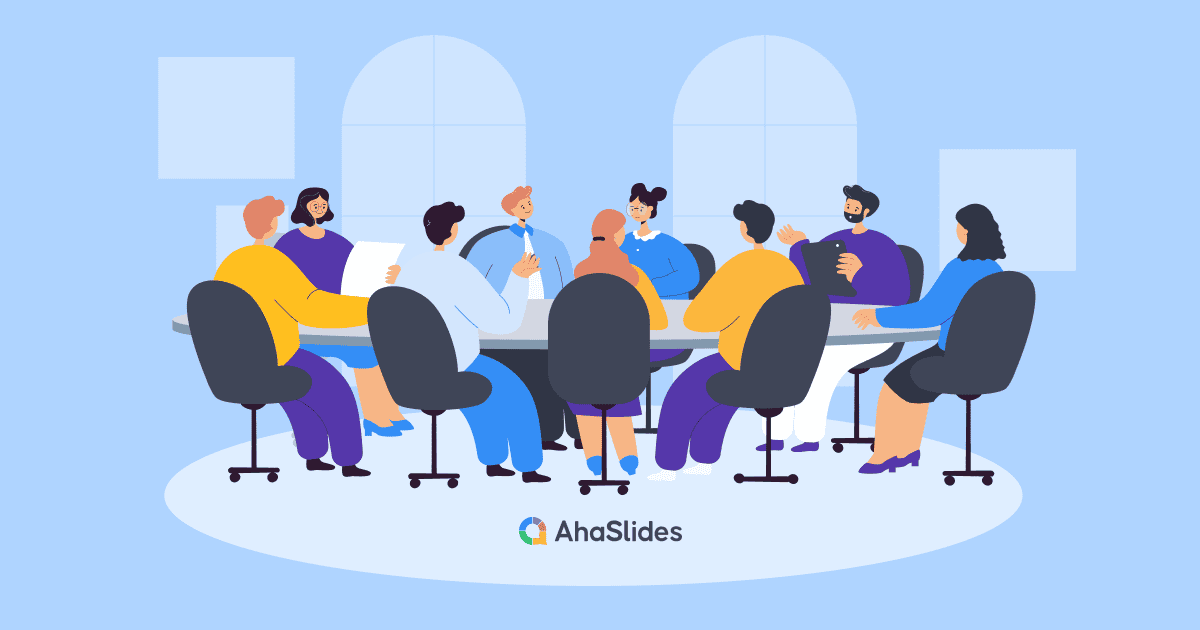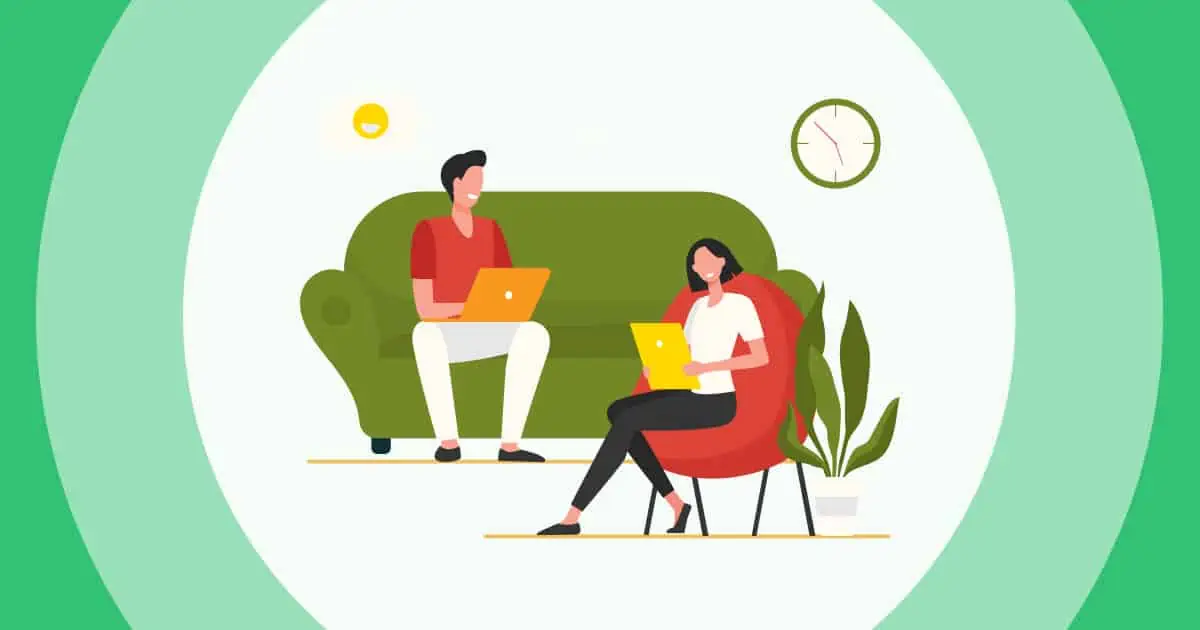The attention gremlin is real. Research from Microsoft found that back-to-back meetings cause cumulative stress buildup in the brain, with beta wave activity (associated with stress) increasing over time. Meanwhile, 95% of business professionals admit to multitasking during meetings—and we all know what that actually means: checking email, scrolling social media, or mentally planning dinner.
The solution isn't shorter meetings (though that helps). It's strategic brain breaks that reset attention, reduce stress, and re-engage your audience.
Unlike random stretching breaks or awkward icebreakers that feel like time-wasters, these 15 brain break activities are specifically designed for trainers, teachers, facilitators, and team leaders who need to combat mid-meeting attention drops, virtual meeting fatigue, and long training session burnout.
What makes these different? They're interactive, backed by neuroscience, and designed to work seamlessly with presentation tools like AhaSlides—so you can actually measure engagement instead of hoping people are paying attention.
Table Of Contents
- Why Brain Breaks Work (The Science Part)
- 15 Interactive Brain Break Activities for Maximum Engagement
- 1. Live Energy Check Poll
- 2. The "Would You Rather" Reset
- 3. Cross-Lateral Movement Challenge
- 4. Lightning Round Word Cloud
- 5. Desk Stretch With Purpose
- 6. Two Truths and a Meeting Lie
- 7. The 1-Minute Mindful Reset
- 8. Stand Up If... Game
- 9. The 5-4-3-2-1 Grounding Exercise
- 10. Quick Draw Challenge
- 11. Desk Chair Yoga Flow
- 12. The Emoji Story
- 13. Speed Networking Roulette
- 14. The Gratitude Lightning Round
- 15. Trivia Energy Booster
- How to Implement Brain Breaks Without Losing Momentum
- The Bottom Line: Brain Breaks Are Meeting Productivity Tools
Why Brain Breaks Work (The Science Part)
Your brain isn't built for marathon focus sessions. Here's what happens without breaks:
After 18-25 minutes: Attention naturally starts to drift. TED Talks are famously capped at 18 minutes for this reason—backed by real neuroscience research showing optimal retention windows.
After 90 minutes: You hit a cognitive wall. Studies show that mental effectiveness significantly decreases, and participants start experiencing information overload.
During back-to-back meetings: Microsoft's brain research using EEG caps revealed that stress accumulates without breaks, but just 10 minutes of mindful activity completely resets beta wave activity, allowing participants to enter the next session fresh.
The ROI of brain breaks: When participants took breaks, they showed positive frontal alpha asymmetry patterns (indicating higher attention and engagement). Without breaks? Negative patterns showing withdrawal and disengagement.
Translation: Brain breaks aren't fluffy time-wasters. They're productivity multipliers.
15 Interactive Brain Break Activities for Maximum Engagement
1. Live Energy Check Poll
Duration: 1-2 minutes
Best for: Any point when energy is flagging
Why it works: Gives your audience agency and shows you care about their state
Instead of guessing whether your audience needs a break, ask them directly with a live poll:
"On a scale of 1-5, how's your energy level right now?"
- 5 = Ready to tackle quantum physics
- 3 = Running on fumes
- 1 = Send coffee immediately
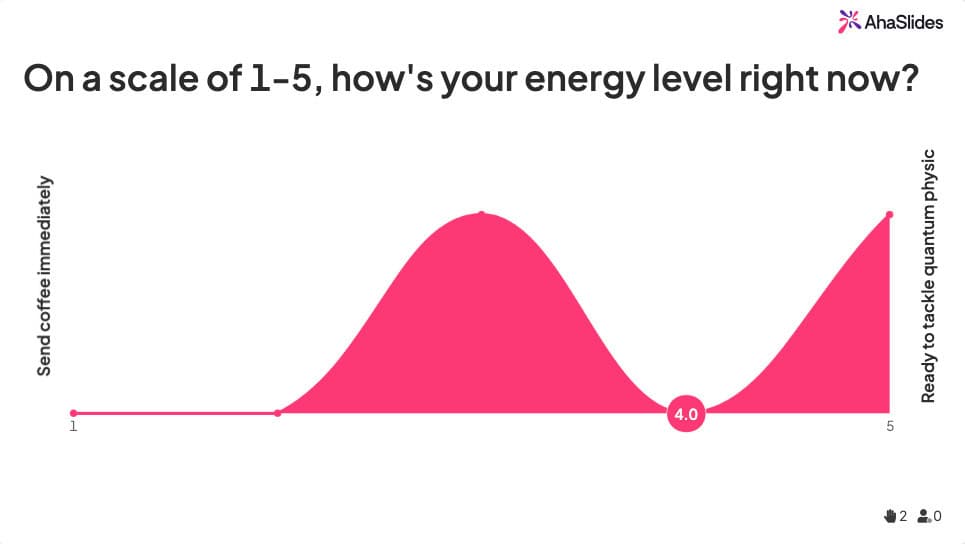
How to make it interactive with AhaSlides:
- Create a live rating scale poll that displays results in real-time
- Use the data to decide: quick 2-minute stretch vs. full 10-minute break
- Show participants they have a voice in the session pace
Pro tip: When results show low energy, acknowledge it: "I see most of you are at a 2-3. Let's do a 5-minute recharge before we dive into the next section."
2. The "Would You Rather" Reset
Duration: 3-4 minutes
Best for: Transitioning between heavy topics
Why it works: Engages decision-making centres of the brain while providing mental relief
Present two absurd choices and have participants vote. The sillier, the better—laughter triggers endorphin release and reduces cortisol (stress hormone).
Examples:
- "Would you rather fight one horse-sized duck or 100 duck-sized horses?"
- "Would you rather only be able to whisper or only be able to shout for the rest of your life?"
- "Would you rather have to sing everything you say or dance everywhere you go?"
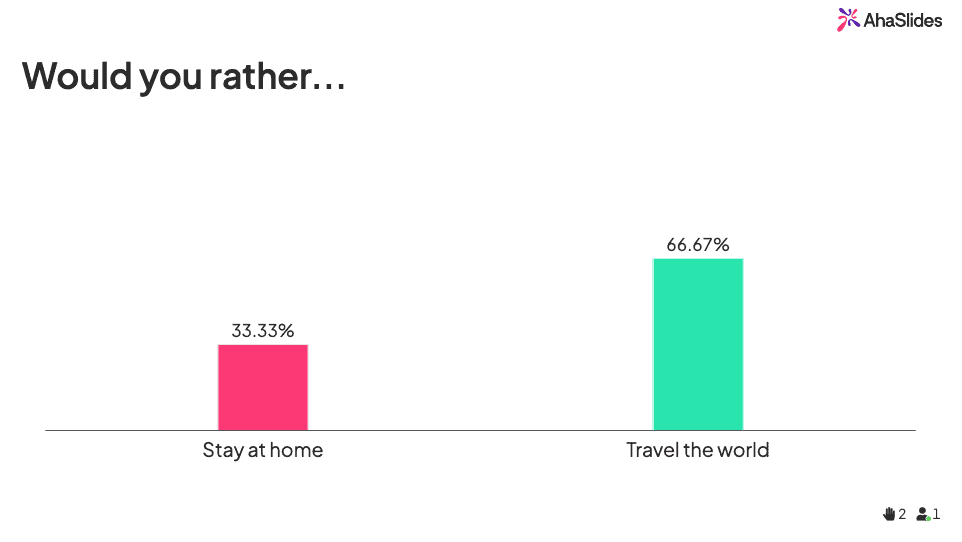
Why trainers love this: It creates "aha moments" of connection when colleagues discover shared preferences—and breaks down formal meeting walls.
3. Cross-Lateral Movement Challenge
Duration: 2 minutes
Best for: Mid-training session energy boost
Why it works: Activates both brain hemispheres, improving focus and coordination
Guide participants through simple movements that cross the body's midline:
- Touch right hand to left knee, then left hand to right knee
- Make figure-8 patterns in the air with your finger while following with your eyes
- Pat your head with one hand while rubbing your belly in circles with the other
Bonus: These movements enhance blood flow to the brain and improve neural connectivity—perfect before problem-solving activities.
4. Lightning Round Word Cloud
Duration: 2-3 minutes
Best for: Topic transitions or capturing quick insights
Why it works: Activates creative thinking and gives everyone a voice
Pose an open-ended prompt and watch responses populate a live word cloud:
- "In one word, how are you feeling right now?"
- "What's the biggest challenge with [topic we just covered]?"
- "Describe your morning in one word"
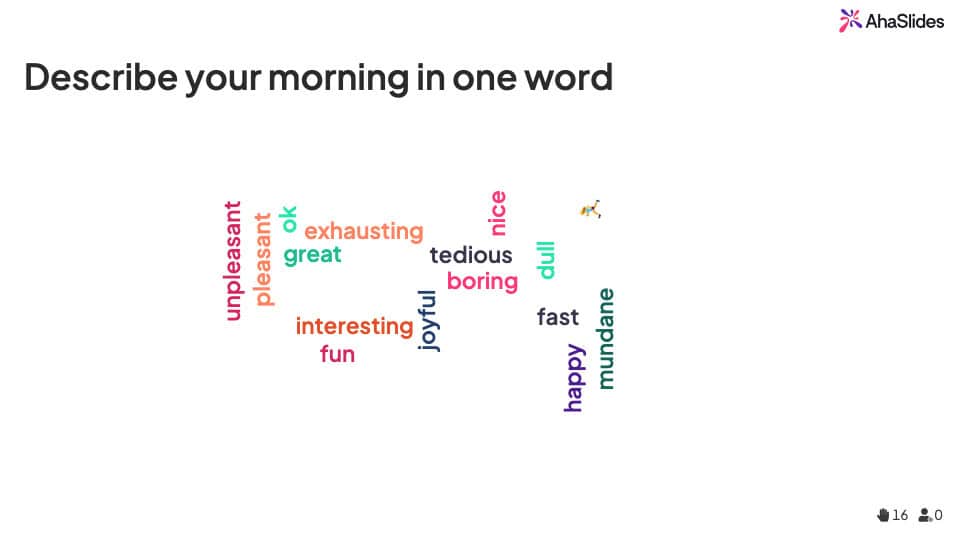
How to make it interactive with AhaSlides:
- Use the Word Cloud feature for instant visual feedback
- The most popular responses appear largest—creating immediate validation
- Screenshot the results to reference later in the session
Why this beats traditional check-ins: It's fast, anonymous, visually engaging, and gives quieter team members an equal voice.
5. Desk Stretch With Purpose
Duration: 3 minutes
Best for: Long virtual meetings
Why it works: Reduces physical tension that causes mental fatigue
Not just "stand up and stretch"—give each stretch a meeting-related purpose:
- Neck rolls: "Roll out all the tension from that last deadline discussion"
- Shoulder shrugs to the ceiling: "Shrug off that project you're worried about"
- Seated spinal twist: "Twist away from your screen and look at something 20 feet away"
- Wrist and finger stretches: "Give your typing hands a break"
Virtual meeting tip: Encourage cameras on during stretches—it normalises movement and builds team connection.
6. Two Truths and a Meeting Lie
Duration: 4-5 minutes
Best for: Building team connection during longer training sessions
Why it works: Combines cognitive challenge with relationship building
Share three statements related to the meeting topic or yourself—two true, one false. Participants vote on which is the lie.
Examples for work contexts:
- "I once fell asleep during a quarterly review / I've been to 15 countries / I can solve a Rubik's cube in under 2 minutes"
- "Our team hit 97% of goals last quarter / We launched in 3 new markets / Our biggest competitor just copied our product"
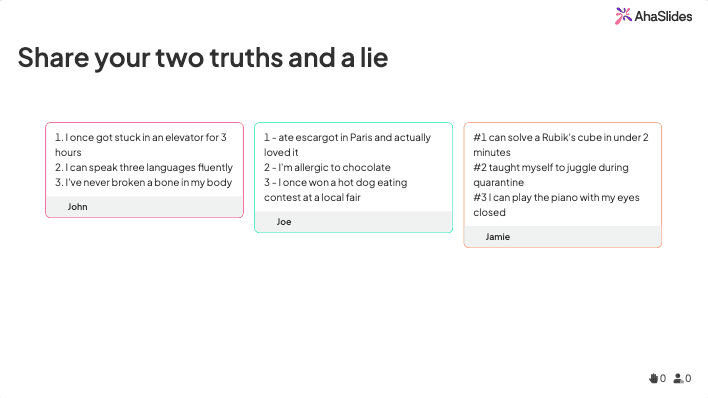
How to make it interactive with AhaSlides:
- Use a Multiple Choice quiz with immediate answer reveals
- Show live voting results before revealing the lie
- Add a leaderboard if you're running multiple rounds
Why managers love this: Learns team dynamics while creating moments of genuine surprise and laughter.
7. The 1-Minute Mindful Reset
Duration: 1-2 minutes
Best for: High-stress discussions or difficult topics
Why it works: Decreases amygdala activity (the brain's stress centre) and activates the parasympathetic nervous system
Guide participants through a simple breathing exercise:
- 4-count inhale (breathe in calm focus)
- 4-count hold (let your mind settle)
- 4-count exhale (release meeting stress)
- 4-count hold (reset completely)
- Repeat 3-4 times
Research-backed: Yale University studies show mindfulness meditation physically reduces the size of the amygdala over time—meaning regular practice builds long-term stress resilience.
8. Stand Up If... Game
Duration: 3-4 minutes
Best for: Re-energising tired afternoon sessions
Why it works: Physical movement + social connection + fun
Call out statements and have participants stand if it applies to them:
- "Stand up if you've had more than 2 cups of coffee today"
- "Stand up if you're working from your kitchen table right now"
- "Stand up if you've ever accidentally sent a message to the wrong person"
- "Stand up if you're an early bird" (then) "Stay standing if you're really a night owl lying to yourself"
How to make it interactive with AhaSlides:
- Display each prompt on a bright, attention-grabbing slide
- For virtual meetings, ask people to use reactions or unmute for quick "Me too!"
- Follow up with a percentage poll: "What % of our team is caffeinated right now?"
Why this works for distributed teams: Creates visibility and shared experience across physical distance.
9. The 5-4-3-2-1 Grounding Exercise
Duration: 2-3 minutes
Best for: After intense discussions or before important decisions
Why it works: Activates all five senses to anchor participants in the present moment
Guide participants through sensory awareness:
- 5 things you can see (look around your space)
- 4 things you can touch (desk, chair, clothing, floor)
- 3 things you can hear (outside sounds, HVAC, keyboard clicks)
- 2 things you can smell (coffee, hand lotion, fresh air)
- 1 thing you can taste (lingering lunch, mint, coffee)
Bonus: This exercise is particularly powerful for remote teams dealing with home-environment distractions.
10. Quick Draw Challenge
Duration: 3-4 minutes
Best for: Creative problem-solving sessions
Why it works: Engages the right brain hemisphere and sparks creativity
Give everyone a simple drawing prompt and 60 seconds to sketch:
- "Draw your ideal workspace"
- "Illustrate how you feel about [project name] in one doodle"
- "Draw this meeting as an animal"
How to make it interactive with AhaSlides:
- Use the Idea Board feature where participants can upload photos of their drawings
- Or keep it low-tech: everyone holds drawings up to their camera
- Vote on categories: "Most creative / Funniest / Most relatable"
Why educators love this: It's a pattern interrupt that activates different neural pathways than verbal processing—perfect before brainstorming sessions.
11. Desk Chair Yoga Flow
Duration: 4-5 minutes
Best for: Long training days (especially virtual)
Why it works: Increases blood flow and oxygen to the brain while releasing physical tension
Lead participants through simple seated movements:
- Seated cat-cow stretch: Arch and round your spine while breathing
- Neck release: Drop ear to shoulder, hold, switch sides
- Seated twist: Hold chair arm, twist gently, breathe
- Ankle circles: Lift one foot, circle 5 times each direction
- Shoulder blade squeeze: Pull shoulders back, squeeze, release
Medical backing: Studies show even brief movement breaks improve cognitive performance and reduce risk of sedentary-related health issues.
12. The Emoji Story
Duration: 2-3 minutes
Best for: Emotional check-ins during difficult training topics
Why it works: Provides psychological safety through playful expression
Prompt participants to choose emojis that represent their feelings:
- "Pick 3 emojis that sum up your week"
- "Show me your reaction to that last section in emojis"
- "How do you feel about learning [new skill]? Express it in emojis"
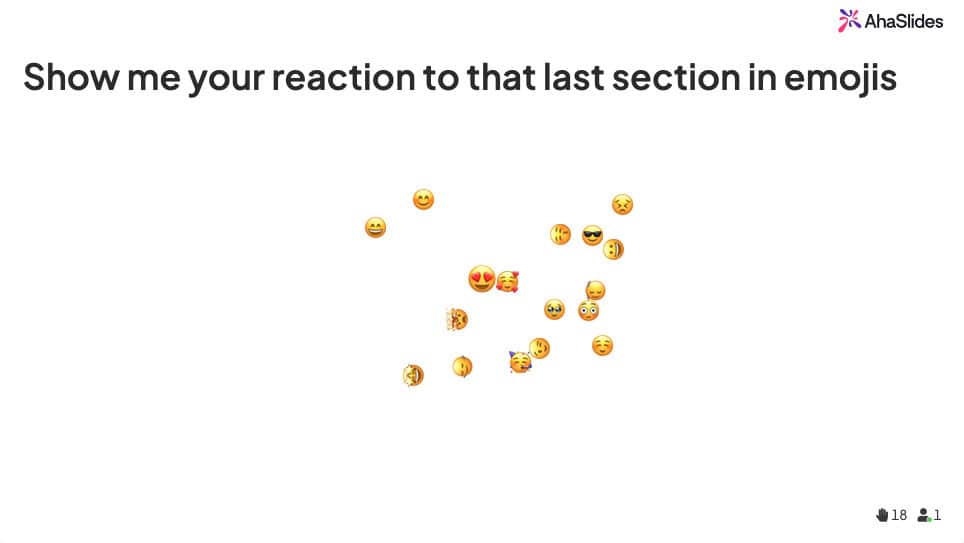
How to make it interactive with AhaSlides:
- Use the Word Cloud feature (participants can type emoji characters)
- Or create a Multiple Choice with emoji options
- Discuss patterns: "I see a lot of 🤯—let's unpack that"
Why this resonates: Emojis transcend language barriers and age gaps, creating immediate emotional connection.
13. Speed Networking Roulette
Duration: 5-7 minutes
Best for: Full-day training sessions with 15+ participants
Why it works: Builds relationships that improve collaboration and engagement
Pair participants randomly for 90-second conversations on a specific prompt:
- "Share your biggest win from last month"
- "What's one skill you want to develop this year?"
- "Tell me about a person who influenced your career"
How to make it virtual with AhaSlides:
- Use breakout room features in Zoom/Teams (if virtual)
- Display a countdown timer on screen
- Rotate pairs 2-3 times with different prompts
- Follow up with a poll: "Did you learn something new about a colleague?"
ROI for organisations: Cross-functional connections improve information flow and reduce silos.
14. The Gratitude Lightning Round
Duration: 2-3 minutes
Best for: End-of-day training or stressful meeting topics
Why it works: Activates reward centres in the brain and shifts mood from negative to positive
Quick prompts for appreciation:
- "Name one thing that went well today"
- "Shout out to someone who helped you this week"
- "What's one thing you're looking forward to?"
How to make it interactive with AhaSlides:
- Use the Open Ended response feature for anonymous submissions
- Read 5-7 responses aloud to the group
Neuroscience: Gratitude practices increase dopamine and serotonin production—the brain's natural mood stabilisers.
15. Trivia Energy Booster
Duration: 5-7 minutes
Best for: After lunch slumps or pre-closing sessions
Why it works: Friendly competition triggers adrenaline and re-engages attention
Ask 3-5 quick trivia questions related (or completely unrelated) to your meeting topic:
- Fun facts about your industry
- Pop culture questions for team bonding
- "Guess the stat" about your company
- General knowledge brain teasers
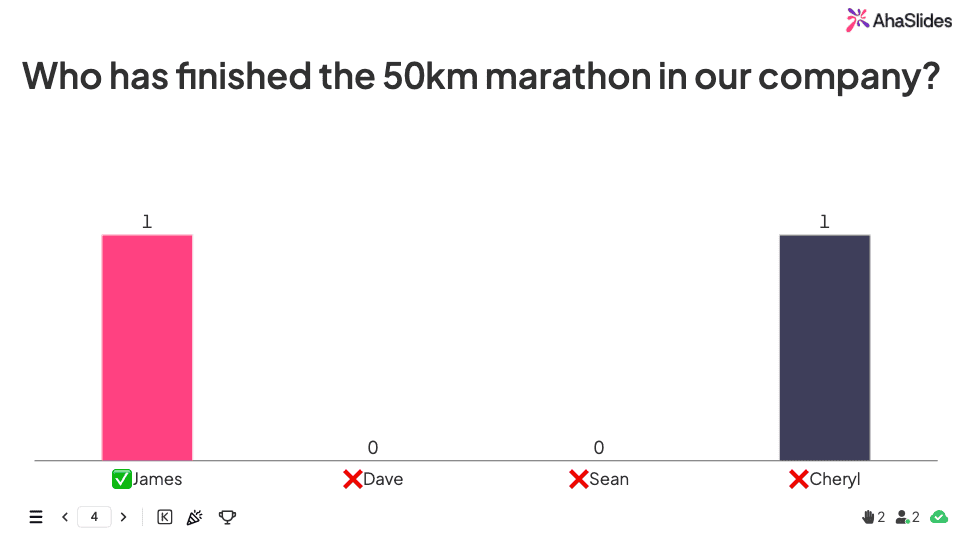
How to make it interactive with AhaSlides:
- Use the Quiz feature with immediate scoring
- Add a live leaderboard to build excitement
- Include fun images or GIFs with each question
- Award a small prize to the winner (or just bragging rights)
Why sales teams love this: Competitive element activates the same reward pathways that drive performance.
How to Implement Brain Breaks Without Losing Momentum
The biggest objection trainers have: "I don't have time for breaks—I have too much content to cover."
The reality: You don't have time NOT to use brain breaks. Here's why:
- Retention drops dramatically after 20-30 minutes without mental breaks
- Meeting productivity decreases by 34% in back-to-back sessions (Microsoft research)
- Information overload means participants forget 70% of what you covered anyway
Implementation framework:
1. Build breaks into your agenda from the start
- For 30-minute meetings: 1 micro-break (1-2 minutes) at the midpoint
- For 60-minute sessions: 2 brain breaks (2-3 minutes each)
- For half-day training: Brain break every 25-30 minutes + longer break every 90 minutes
2. Make them predictable. Signal breaks in advance: "In 15 minutes, we'll take a quick 2-minute energy reset before diving into the solution phase."
3. Match the break to the need
| If your audience is... | Use this type of break |
|---|---|
| Mentally exhausted | Mindfulness / Breathing exercises |
| Physically tired | Movement-based activities |
| Socially disconnected | Connection-building activities |
| Emotionally drained | Gratitude / Humour-based breaks |
| Losing focus | High-energy interactive games |
4. Measure what works. Use AhaSlides' built-in analytics to track:
- Participation rates during breaks
- Energy level polls before vs. after breaks
- Post-session feedback on break effectiveness
The Bottom Line: Brain Breaks Are Meeting Productivity Tools
Stop thinking of brain breaks as "nice to have" extras that eat into your agenda time.
Start treating them as strategic interventions that:
- Reset stress accumulation (proven by Microsoft's EEG brain research)
- Improve information retention (backed by neuroscience on learning intervals)
- Increase engagement (measured by participation and attention metrics)
- Build psychological safety (essential for high-performing teams)
- Prevent burnout (critical for long-term productivity)
The meetings that feel too packed for breaks? Those are exactly the ones that need them most.
Your action plan:
- Pick 3-5 brain break activities from this list that match your meeting style
- Schedule them into your next training session or team meeting
- Make at least one interactive using AhaSlides (try the free plan to start)
- Measure engagement before and after implementing brain breaks
- Adjust based on what your audience responds to best
Your audience's attention is your most valuable currency. Brain breaks are how you protect it.

